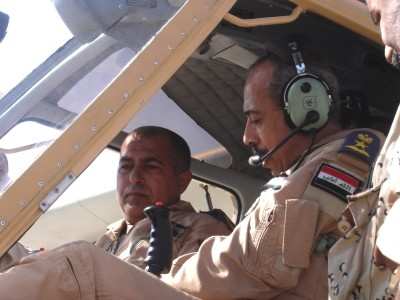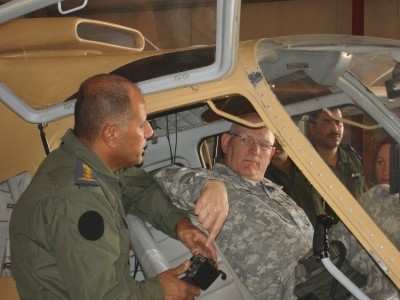Mon, Oct 05, 2009
Combat-Experienced Pilots Learning New Camera Targeting
Systems
Members of Iraq's 70th Air Reconnaissance Squadron completed the
first phase of intelligence, surveillance and reconnaissance
training with Minnesota National Guard's 34th Red Bull Infantry
Division's intelligence section in Basra, Iraq.

U.S. Army
Photo by Staff Sgt. Eric Ebner
Iraqi fighter pilots who have combat experience from the
Iran-Iraq War -- some with as many as 800 hours of combat flight
time -- worked with soldiers from the 34th Infantry Division's
intelligence section to become familiar with remote-control
surveillance cameras attached to their Sama CH200 and SBL-360
Seeker aircraft. The aircraft are fitted with a FLIR Systems 8500
electro-optics/infrared camera system.
"These guys are used to the old fixed cameras," said Army Staff
Sgt. Eric Ebner, operations analyst with 34th Infantry Division.
"You just turn them on and fly over. The biggest problem they had
[with the modern remote-control cameras] was coordinating the
camera with the movement of the plane."
The Iraqi pilots -- who flew the Russian MiG 21, 23 and 25; the
Sukov 24; and French Mirage fighters -- became familiar with the
camera systems operation and capabilities during ground training.
The instructors ran them through the systems in a hands-on course
before they took to the sky to work with the systems in targeting
items on the ground. "They have to learn to talk to the ground
commander to provide a play-by-play from the air," Ebner said.
The next phase of instruction will continue focusing on the
system's technical capabilities and allow the pilots to coordinate
their efforts with the Iraqi army. The pilots will assist the army
with more efficient placement and use of Iraqi resources throughout
their areas of operation.

U.S. Army
Photo by Staff Sgt. Eric Ebner
The training's goal is to allow the Iraqis to use their own
pilots and resources to support the intelligence, surveillance and
reconnaissance mission across Multinational Division South's area
of operations, and to minimize the need for reliance on U.S.
resources to accomplish their mission.
ANN Salutes Army Sgt. 1st Class Jeff Mullett serving in
Multinational Division South.
More News
Aero Linx: Model Aeronautical Association of Australia MAAA clubs are about fun flying, camaraderie and community. For over 75 years, the MAAA has been Australia’s largest fl>[...]
Touchdown Zone Lighting Two rows of transverse light bars located symmetrically about the runway centerline normally at 100 foot intervals. The basic system extends 3,000 feet alon>[...]
“Discovery and innovation are central to our mission at Virgin Galactic. We’re excited to build on our successful record of facilitating scientific experiments in subor>[...]
How To Get A Story On Aero-TV News/Feature Programming How do I submit a story idea or lead to Aero-TV? If you would like to submit a story idea or lead, please contact Jim Campbel>[...]
Student Pilot Reported That During Rotation, “All Of A Sudden The Back Of The Plane Kicked To The Right..." Analysis: The student pilot reported that during rotation, “>[...]
 ANN's Daily Aero-Linx (05.02.24)
ANN's Daily Aero-Linx (05.02.24) ANN's Daily Aero-Term (05.02.24): Touchdown Zone Lighting
ANN's Daily Aero-Term (05.02.24): Touchdown Zone Lighting Aero-News: Quote of the Day (05.02.24)
Aero-News: Quote of the Day (05.02.24) ANN FAQ: Contributing To Aero-TV
ANN FAQ: Contributing To Aero-TV NTSB Final Report: Cirrus Design Corp SR20
NTSB Final Report: Cirrus Design Corp SR20




